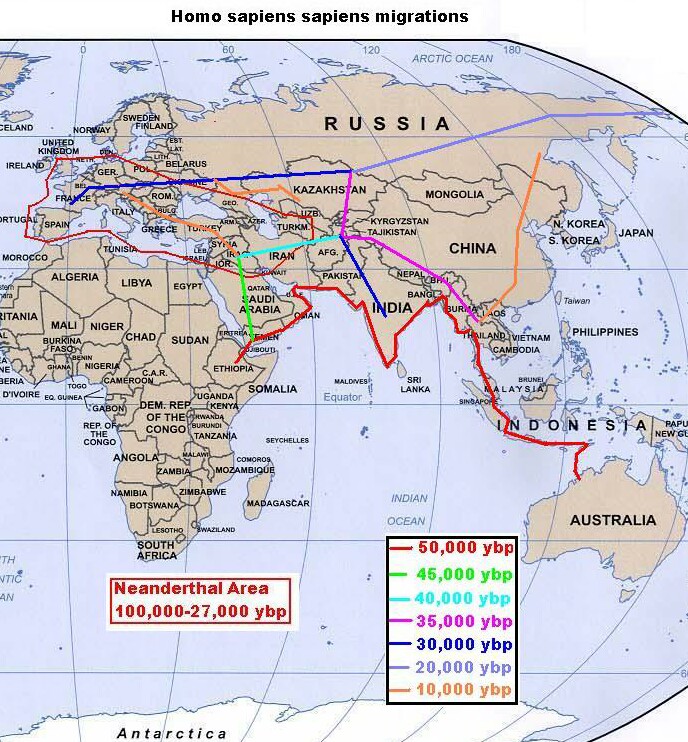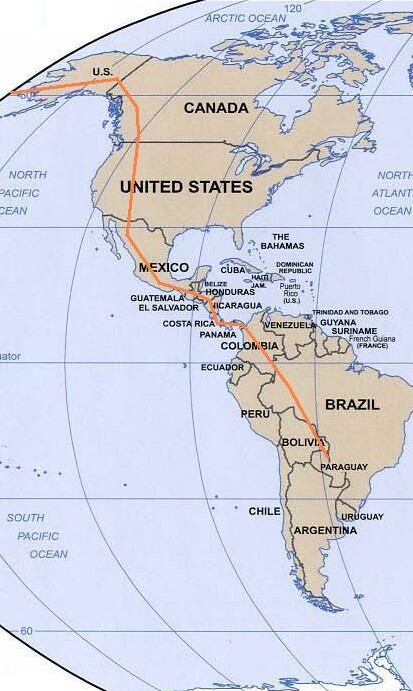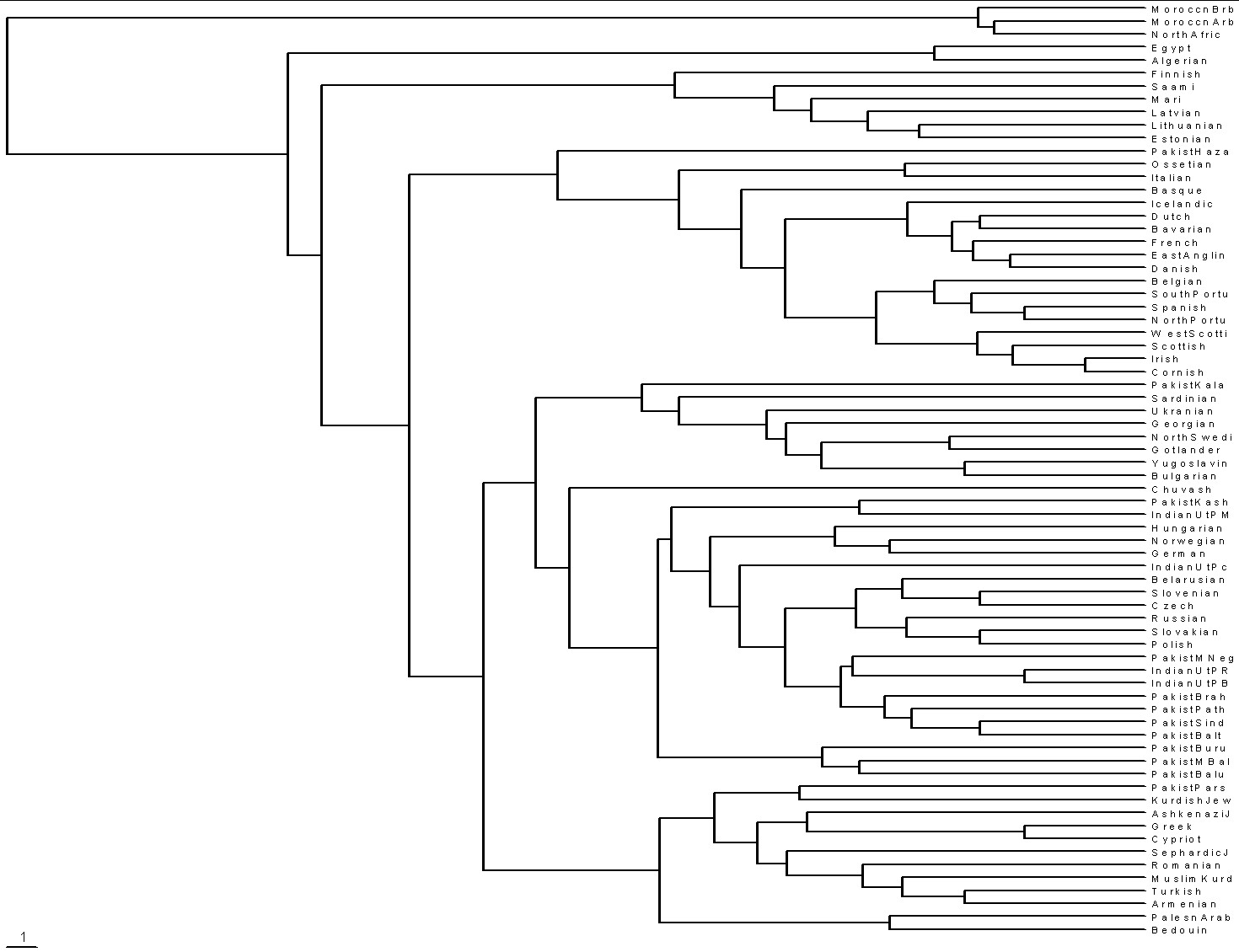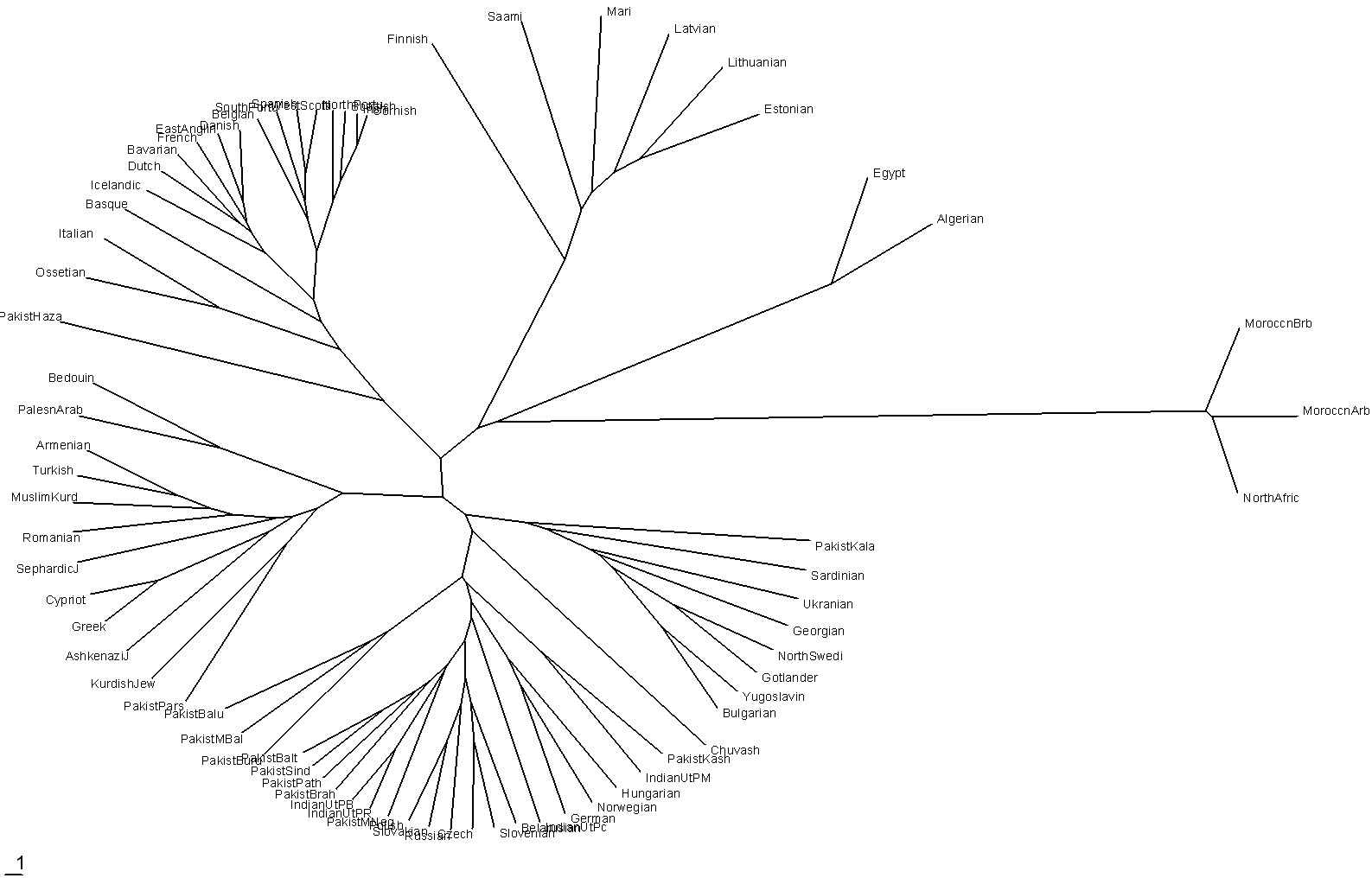Dates are approximate.
One view of
pre-Hominid and Hominid history
See skulls of
ancient hominids. |
| 5,000,000 ybp |
Hominids separated from other primates |
| 2,000,000 ybp |
Homo habilis |
| 1,750,000 ybp |
Initial hominid exodus from Africa |
| 1,500,000 ybp |
Home erectus |
| 1,000,000 ybp |
Early hominids in Spain and Central Asia |
| 500,000 ybp |
Common ancestor of Homo sapiens sapiens (Hss) and
Homo neanderthalensis |
| 400,000 ybp |
Early hominids in China |
| 150,000 ybp |
Mitochondrial Eve in Africa |
| 100,000 ybp |
Some Homo sapiens sapiens left Africa into Middle
East |
| 71,000 ybp |
Eruption of Toba, Sumatra volcano and the ensuing cold
millennium
which killed almost all Hss (estimate of 5,000 left)
This was
right at a minimum temperture of about 7 degrees C below current
temperature.
The eruption took the temperature down to about 9 degrees C
below current temperature for about 1000 years. |
| 60,000 ypb |
Y-chromosome Adam |
| 50,000 ybp |
Hss Eurasians separated out from Africans, followed
coast lines and arrived in Australia |
| 40,000 ybp |
Europeans separated out from Eurasians |
| 40,000 ybp |
Modern humans reached southern Siberia |
| 35,000 ybp |
Modern humans reached Europe
Earliest Paleolithic
cave art in Fumane Cave near Verona, Italy |
| 30,000 ybp |
First major wave of migration into India from the
Middle East |
| 28,000 ybp |
Date of latest fossil of Homo Neanderthalensis. |
| 25,0000 |
Paleolithic Hss migrated south to southern France
and northern Spain because of ice-age cold |
| 20,000 ypb |
Modern humans reached the Asian Arctic |
| 18,000 ypp |
Paleolithic Hss congregated in
ice-age refugia in the Iberian Peninsula, the Balkans
and the Ukraine. |
| 15,000 ybp |
Northeast Asians migrated into North America through
the Bering Straits, then dry |
| 14,000 ybp |
A large Antarctica ice sheet melted and caused a rapid rise
in sea level and warming of Europe. |
| 12,000-10,000 ybp |
Europe repopulated after Last Glacial Maximum from the
three ice-age refugia.
[Y-chromosome haplogroups R1b (Iberian Peninsula), I
(Balkans) and R1a (Ukraine).]
It is easy to see why Athens and Rome developed advanced "civilizations" first in Europe.
(Click on maps for references.) |
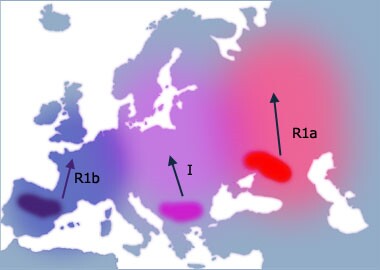 |
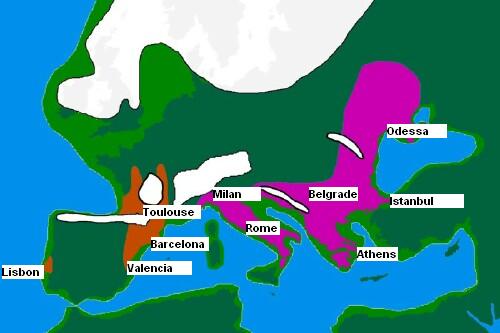 |
| 10,000 ybp |
Agriculture began in Middle East |
| 8,500 ybp |
Earliest known permanent settlement at Jericho in
the Middle East |
| 8,200 ybp |
Huge ice dam broke in northeast North America, which
caused the filling of the Irish Sea, the North Sea, the English Channel and the
Baltic Sea.
This led to much colder temperatures for about 300-500 years in
western Europe. This caused Europeans to separate into isolated groups.
Articles about this:
The Europeans left in western Europe are called Paleolithic.
|
| 8,000 ybp |
Neolithic farmers migrated from the Middle East to Eastern
Europe.
[Y-chromosome haplogroups I3b, F, J2, G2 and N3.]
Agriculture
developed in this group and they later joined the Paleolithic group in western
Europe. |
| A map of Europe
and the continental shelf, which gives the basic outline of the European land
area before the c8200 ybp flooding: |
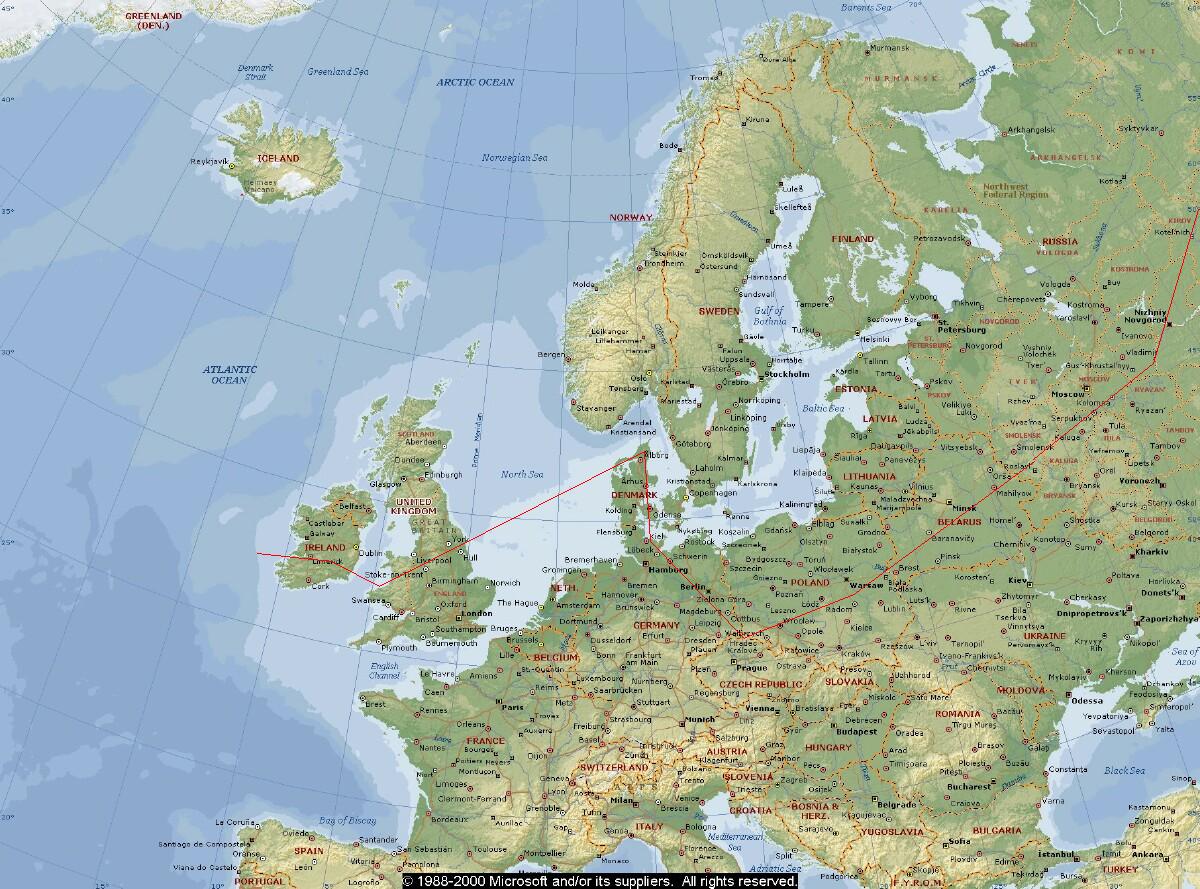
This map was generated
by Micrsoft's Interactive World Atlas
The red line is the approximate
southern limit of the glacial cover at the peak of the Ice Age c18,000
ybp. |
| 7,600 ybp |
The Black Sea and surrounding area flooded with salt
water by the breaching of a narrow strip of land by the rising Mediterranean
Sea to create the Strait of Bosporus:
|
| 5,500 ybp |
Wheel invented |
| 4,000 ybp |
Hss migrated to Polynesian Islands |
| Climate History |
| 150,000 ybp to present |
Africa climate:
http://www.esd.ornl.gov/projects/qen/nercAFRICA.html |
| 120,000-15,000 ybp |
Last Major Ice Age. The following graph shows the temperature
measurements (left scale) in the
Vostok Antarctica ice core, along with
a
particular calculation of the solar insolation (dashed line and right
scale; due to interactions of other planets and the moon with the earth,
changing the earth's orbit and orientation relative to the sun) and a
polynomial fit to the temperatures (solid line):
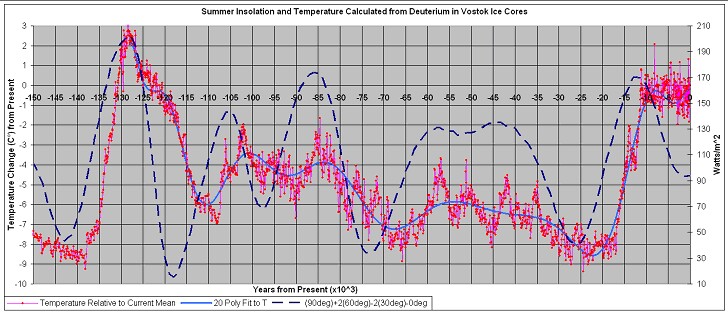
The
temperature data and the insolation calculation are strongly correlated with a
5000 year temperature lag relative to the insolation.
Two Major
Interglacials between the last Major Ice Age and the previous Major Ice Age and
the next Major Ice Age (the one we are now in) are shown.
Notice the four
Minor Ice Ages and five Minor Interglacials within the last Major Ice
Age.
Also, notice the many Little Ice Ages and Little Interglacials within
the Minor Ice Ages.
Notice the prolongation of the current Major
Interglacial (super-interglacial) relative to the last Major Interglacial (and
others before it) due to exponential increases in human population and energy
and matter released into the atmosphere.
Direct measurements of temperature
(in C degrees on left scale) compared to world population (in billions on right
scale) over the last thousand years:
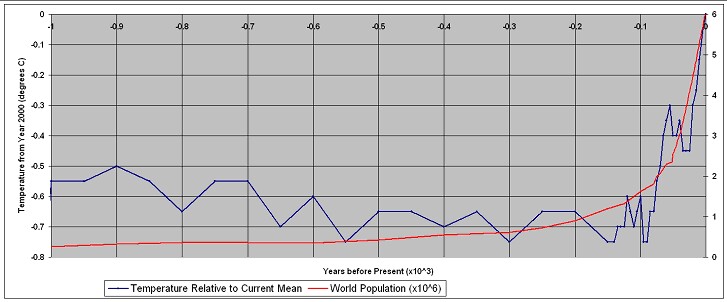
So, until humans quit dumping stored
earth energy and materials into the atmosphere (which they will in a few
hundred years as that stored energy is depleted), the super-interglacial
mentioned above will increase in temperature, even though the solar insolation
has been decreasing. This will probably be enhanced by an upward trend in the
solar irradiance.
For more details, see:
http://www.arts.bev.net/roperldavid/InsolationIceAges.pdf
(a large pdf file). |
| 20,000 ybp |
Global temperature averages about 10 degrees C cooler than
today. |
| 14,000 ybp |
A sudden warming followed by a decline. See
graph above. |
| 11,600 ybp |
In less than one decade there was a sudden warming. See
http://globe.ngdc.noaa.gov/paleo/ctl/abrupt.html |
| 8,200 ybp |
Huge ice dam broke in northeast North America, which caused the
filling of the English channel and much flooding and much colder temperatures
for about 300-500 years in western Europe. This caused Europeans to separate
into isolated groups. |
It might be of interest to view a time-ordered (rooted tree) phylogram
and a phylogenetic network (unrooted tree) of 72 populations as reported in
(web page no longer available). [To create time-ordered phylograms, I use the
PHYLIP/Kitsch
software using the relative-mutations matrix to generate a tree file
(*.tre) to be plotted by the
TreeView software. (For a description of how I do it,
see PHYLIPTreeViewUse.htm.)]:





